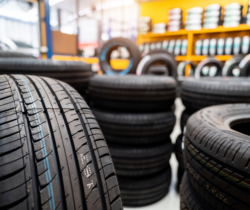Revolutionizing Tire Manufacturing with Automation

The tire manufacturing industry has come a long way over the years, but there is still a lot of room for improvement. The traditional reliance on manual labor and outdated technologies has led to inefficiencies, high costs, and a lack of flexibility in the production process. However, with the advent of automation technologies, the industry is experiencing a significant shift towards increased efficiency, improved product quality, and greater safety and flexibility. We will explore the many benefits of automation in the tire manufacturing industry, the various automation technologies used in the process, and what the future of the industry might look like.
Increased Efficiency

One of the key benefits of automation in tire manufacturing is the ability to achieve faster production rates and shorter lead times. Automated machines and robots can work at a much faster pace than human workers, which means that more tires can be produced in a shorter amount of time. Additionally, automation allows for precise, consistent tasks to be performed with minimal human intervention, reducing the risk of errors and delays. This means that orders can be filled more quickly and delivered to customers sooner, improving the overall efficiency of the production process. Another benefit of automation is that it allows for 24/7 operation, leading to cost savings. Automated machines do not need breaks or time off and can work around the clock to produce tires. This means that manufacturers can run their factories for longer hours and produce more tires, without the need to hire additional human workers. Furthermore, the automation process is more consistent and reliable than manual labor, which leads to less downtime and wasted resources. Automation also allows manufacturers to optimize the production process and reduce waste, by using real-time data and analytics to make adjustments and improve output. Overall, automation allows manufacturers to keep up with the growing demand for tires, with less time and effort required.
Improved Product Quality
Automation in tire manufacturing also leads to improved product quality. Automated machines and robots are capable of performing tasks with precision and consistency, which helps to reduce the risk of human error. This results in fewer defects and less waste, which means that more high-quality tires are produced. Automated machines and robots can also be programmed to perform quality control checks, allowing manufacturers to ensure that their tires meet the necessary safety and performance standards. Furthermore, automation allows manufacturers to monitor the production process in real-time, which means that any issues can be quickly identified and addressed. This leads to less downtime and wasted resources, and also allows manufacturers to make adjustments to the process to improve the quality of their tires. Additionally, automation allows for the use of advanced technologies like sensors, cameras, and artificial intelligence to monitor the production process and detect defects that are not visible to the human eye. This means that manufacturers can produce tires that are not only high-quality, but also safer and more reliable.
Safety Benefits
Automation in tire manufacturing also leads to improved safety and flexibility in the production process. Automated machines and robots are able to perform tasks that are dangerous or physically demanding for human workers, such as handling heavy equipment or working in high-temperature environments. This reduces the risk of injuries and accidents, and also allows manufacturers to comply with safety regulations. Automated machines and robots also require less maintenance and repairs than traditional equipment, which means that manufacturers can save money and resources in the long run. Additionally, automation allows manufacturers to quickly and easily change the production process to meet changing market conditions or customer demands. Automated machines and robots can be reprogrammed to produce different types of tires, or to make adjustments to the production process, without the need for extensive retraining or rehiring of human workers. This means that manufacturers can be more responsive to the needs of their customers and can adapt to changes in the market more easily. Overall, automation improves the safety and flexibility of the production process, and allows manufacturers to stay competitive in the market.
Flexibility in the Production Process
Lastly, Automation in tire manufacturing leads to cost savings. Automated machines and robots require less human labor, which means that manufacturers can save money on wages and benefits. Additionally, automation allows for 24/7 operation, which means that manufacturers can run their factories for longer hours and produce more tires, without the need to hire additional human workers. Automated machines and robots also require less maintenance and repairs than traditional equipment, which means that manufacturers can save money and resources in the long run. Furthermore, automation allows manufacturers to optimize the production process and reduce waste, by using real-time data and analytics to make adjustments and improve output. This results in higher efficiency and fewer defects, which means that manufacturers can produce more tires with less resources. Lastly automation leads to improved product quality, which means that manufacturers can sell more tires at a higher price, resulting in higher profits. Overall, automation in tire manufacturing leads to cost savings in many ways and allows manufacturers to stay competitive in the market while boosting profits.
Types of Automation Technologies
Tire manufacturing automation relies heavily on various technologies like robotics, machine learning, and artificial intelligence.
- Robotics are used in tire manufacturing to automate repetitive tasks such as tire assembly, handling and packaging of tires. Robotics technology is also used to automate the process of tire building, where a robot is used to place tread rubber, build the green tire, and apply the tire’s final shape. Robotics technology is also used to automate the process of tire curing, where a robot is used to place the tire in the mold and apply the pressure and heat needed to cure the tire.
- Machine learning is another technology that is used in tire manufacturing automation. Machine learning algorithms are used to optimize the production process and improve the quality of the tires produced. Machine learning algorithms are used to analyze data from sensors and cameras on the production line, and to make adjustments to the process based on that data. This allows manufacturers to optimize the production process in real-time, and to detect and correct defects before they become a problem.
- Artificial intelligence (AI) is also being used in tire manufacturing automation. AI-based systems are used to predict and prevent equipment failures and optimize the production process. AI-based systems are also used to predict the service life of a tire and schedule maintenance accordingly. AI-based systems can also be used to predict the demand for tires and adjust production accordingly.




